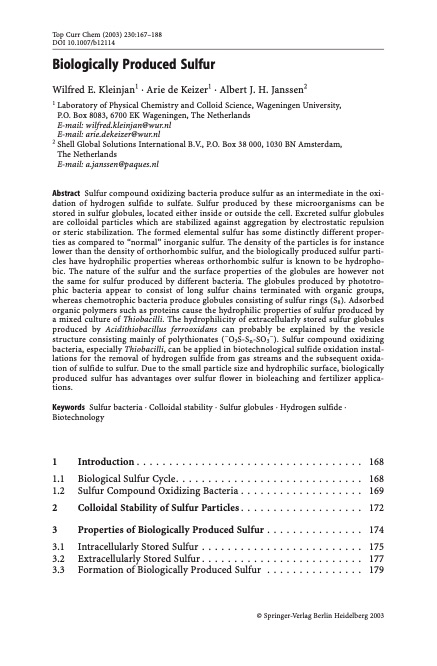
PDF Publication Title:
Text from PDF Page: 177
Top Curr Chem (2003) 230:167–188 DOI 10.1007/b12114 Biologically Produced Sulfur Wilfred E. Kleinjan1 · Arie de Keizer1 · Albert J. H. Janssen2 1 Laboratory of Physical Chemistry and Colloid Science, Wageningen University, P.O. Box 8083, 6700 EK Wageningen, The Netherlands E-mail: wilfred.kleinjan@wur.nl E-mail: arie.dekeizer@wur.nl 2 Shell Global Solutions International B.V., P.O. Box 38 000, 1030 BN Amsterdam, The Netherlands E-mail: a.janssen@paques.nl Abstract Sulfur compound oxidizing bacteria produce sulfur as an intermediate in the oxi- dation of hydrogen sulfide to sulfate. Sulfur produced by these microorganisms can be stored in sulfur globules, located either inside or outside the cell. Excreted sulfur globules are colloidal particles which are stabilized against aggregation by electrostatic repulsion or steric stabilization. The formed elemental sulfur has some distinctly different proper- ties as compared to “normal” inorganic sulfur. The density of the particles is for instance lower than the density of orthorhombic sulfur, and the biologically produced sulfur parti- cles have hydrophilic properties whereas orthorhombic sulfur is known to be hydropho- bic. The nature of the sulfur and the surface properties of the globules are however not the same for sulfur produced by different bacteria. The globules produced by phototro- phic bacteria appear to consist of long sulfur chains terminated with organic groups, whereas chemotrophic bacteria produce globules consisting of sulfur rings (S8). Adsorbed organic polymers such as proteins cause the hydrophilic properties of sulfur produced by a mixed culture of Thiobacilli. The hydrophilicity of extracellularly stored sulfur globules produced by Acidithiobacillus ferrooxidans can probably be explained by the vesicle structure consisting mainly of polythionates (O3S-Sn-SO3). Sulfur compound oxidizing bacteria, especially Thiobacilli, can be applied in biotechnological sulfide oxidation instal- lations for the removal of hydrogen sulfide from gas streams and the subsequent oxida- tion of sulfide to sulfur. Due to the small particle size and hydrophilic surface, biologically produced sulfur has advantages over sulfur flower in bioleaching and fertilizer applica- tions. Keywords Sulfur bacteria · Colloidal stability · Sulfur globules · Hydrogen sulfide · Biotechnology 1 Introduction................................... 168 1.1 BiologicalSulfurCycle............................. 168 1.2 SulfurCompoundOxidizingBacteria................... 169 2 ColloidalStabilityofSulfurParticles................... 172 3 PropertiesofBiologicallyProducedSulfur. . . . . . . . . . . . . . . 174 3.1 IntracellularlyStoredSulfur......................... 175 3.2 ExtracellularlyStoredSulfur......................... 177 3.3 FormationofBiologicallyProducedSulfur . . . . . . . . . . . . . . . 179 Springer-Verlag Berlin Heidelberg 2003PDF Image | Topics in Current Chemistry

PDF Search Title:
Topics in Current ChemistryOriginal File Name Searched:
Elemental-Sulfur-und-Sulfur-Rich-Compounds-I.pdfDIY PDF Search: Google It | Yahoo | Bing
Sulfur Deposition on Carbon Nanofibers using Supercritical CO2 Sulfur Deposition on Carbon Nanofibers using Supercritical CO2. Gamma sulfur also known as mother of pearl sulfur and nacreous sulfur... More Info
CO2 Organic Rankine Cycle Experimenter Platform The supercritical CO2 phase change system is both a heat pump and organic rankine cycle which can be used for those purposes and as a supercritical extractor for advanced subcritical and supercritical extraction technology. Uses include producing nanoparticles, precious metal CO2 extraction, lithium battery recycling, and other applications... More Info
| CONTACT TEL: 608-238-6001 Email: greg@infinityturbine.com | RSS | AMP |